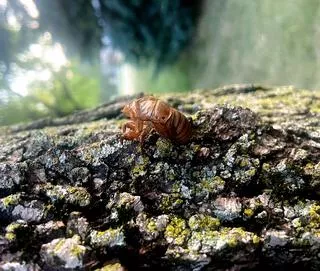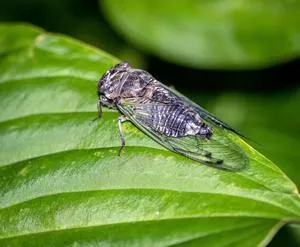By Bob Suchanek
Water and Wetlands Steward
Adult cicadas appear every year during the last weeks of summer in Minnesota. Sometimes called dog-day cicadas, these big insects are members of the “true bug” order hemiptera with mouths evolved to suck fluids from other living things. Some hemipterans enjoy a blood meal (bed bugs for example) but cicadas are strict vegetarians and dine on plant juices.
Cicadas begin life as eggs inserted into small incisions made by their mothers on tree twigs well above the ground. After they hatch, these tiny insects (initially smaller than an ant) drop from their birth branch, drift to the ground, and burrow into the soil to find plant rootlets to feed on. This begins a multiyear life dedicated to feeding, growth, and exoskeleton shedding (molting). They finally emerge from the ground after 2 to 5 years, molt for the last time, and become two-inch-long winged adults. The critical business of reproduction begins with the males calling the females by vibrating an internal membrane that produces a power line like buzzing sound. The females that respond begin the cycles of a new generation all over again.
Beyond Minnesota
There are over 3,000 cicada species worldwide and most have life cycles similar to the dog-day cicada. Seven species do not. These exceptional species are the periodical cicadas. They don’t appear every year but rather time their emergence to 13- and 17-year cycles. All periodical cicadas live in North America, generally east and south of Minnesota, and they are all in the insect genus Magicicada. The periodical cicada timing strategy appears to be beneficial in that it increases the adult population for mating at emergence as well as overwhelming the consumption capacity of predators (birds, mammals, fish).
Last year Brood X, the largest of the 17-year cicada broods, emerged in parts of 15 states across the eastern and southern United States. Billions of cicadas emerged, some at a rate of over a million cicadas per acre, molted, and produced a new generation that’s scheduled to return in 2038. This emergence was a feast for those that cared to dine on the tasty protein-rich bug bonanza. The massive invasion raised concerns about damage to trees but this is an ancient, well-adapted phenomenon and damage appears to have been very limited. It's thought that this behavior may have evolved many thousands of years ago as a response to ice age climatic changes.
Sightings
Since we have only annual cicadas in Minnesota, we don’t see anything like the numbers of cicadas that are seen when periodical cicadas emerge. This makes the modest numbers of these amazing creatures all the more to be appreciated. Adult cicada sightings are fewer than exoskeleton sightings, but both can be seen on and around trees every August and September.
The empty brown shell in the photo of the annual cicada exoskeleton is the outer covering of the larval insect (technically called a nymph) that once occupied it; a monument to a life well lived, transformed, and soon to be completed. The nymph is now a handsome winged insect like the one sitting on a leaf in the adult cicada photo.

Annual Cicada Exoskeleton
Photo Credit: Jennifer Turner

Annual Cicada
Photo Credit: Steve Ring
To help cicadas and all Minnesota wildlife consider joining the Forests and Wildlife volunteer team.
Some Sources
https://www.scientificamerican.com/article/brood-x-cicadas-are-emerging-at-last1/